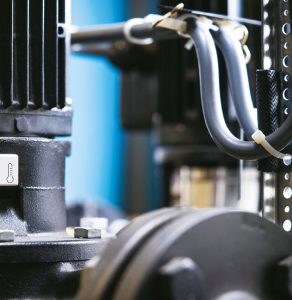NET ZERO OBJECTIVES
The stark warning at last year’s COP26 that climate change emergency has become a ‘code red’ emergency has also re-energised environmental efforts, mounting corporate and legislative pressure on organisations to commit to net zero.
It’s a well-known fact but one that bears repeating: the built environment contributes 40 per cent of the world’s carbon emissions. Recent JLL research suggests that this statistic is at least widely understood, with 56 per cent of occupiers reporting that they are addressing carbon reduction as part of their CRE strategy and a further 29 per cent looking to address it by 2025. The study also revealed that many occupiers view data capabilities, including smart buildings and energy monitoring, as a way of improving their reporting and measurement capabilities.
That’s where smart engineering comes in. Tracking energy consumption data from equipment, lighting and energy meters within a single system gives organisations a clear sustainability baseline for active process improvement. In the short term, organisations can use this data to inform current OPEX based on optimising, recommissioning, and managing the existing infrastructure. Over the long term, it can be used as the basis for future strategic asset management plans and investments that lead to more significant carbon reduction.
Digitising maintenance also produces sustainability benefits through changes in the way engineers work. Fewer resources are consumed by engineering teams due to the eradication of labour-intensive manual tasks, such as Legionella testing, and the reduction in waste water, heating energy use, and unnecessary trips.
SMART ENGINEERING IN ACTION
In 2019, Integral transitioned a leading UK asset management firm to smart engineering with a focus on carbon footprint reduction, energy optimisation, labour optimisation, asset optimisation and customer experience. During 2020, we were also tasked with aligning these efforts with the company’s COVID-19 closure and re-entry protocols.
To make this happen, we initiated a three-stage approach to connect, control and optimise. Firstly, we digitised the entire infrastructure and integrated predictive maintenance to the client’s BMS across eight sites. Doing this enabled us to view real-time and historical data for any equipment, device or sensor across all zones, floors, and buildings. We can save the data the customer wants to see in widgets for easy retrieval and download reports on Legionella, equipment operations, utilities and health and comfort factors.
We also utilise dynamic and occupancy-based schedules rather than rigid schedules to maximise energy savings and maintain optimal performance. By creating customised alerts and point actions based on conditions, we can automate repetitive tasks and reduce labour input, detect outliers, minimise via operational optimisations, and reduce equipment costs by extending assets’ operational life.
 Since deploying smart engineering with the asset management company, we increased asset performance by 24 per cent between March and September 2020, helped maintain an average employee health and comfort score of 71 per cent, reduced equipment runtime and maintenance requirements in all buildings, and made electrical savings of £183,331 across seven of the eight sites.
Since deploying smart engineering with the asset management company, we increased asset performance by 24 per cent between March and September 2020, helped maintain an average employee health and comfort score of 71 per cent, reduced equipment runtime and maintenance requirements in all buildings, and made electrical savings of £183,331 across seven of the eight sites.
A GAME CHANGER
For facilities managers, maintenance has always been crucial to ensuring compliance, high health & safety standards, and business continuity. Now, however, smart technologies are transforming maintenance into a more complex and strategic service. By collecting more accurate data on asset condition and performance, facilities managers can play a more pivotal role in their organisation’s decision-making and strategy by supporting real estate and workplace transformations, net zero targets, employee experience or wellbeing initiatives, and more. That can only be a good thing for the reputation and continual evolution of the FM profession.





